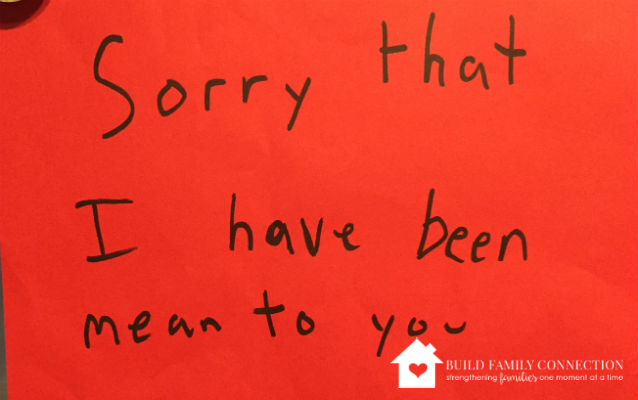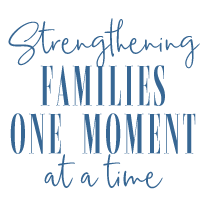Fighting siblings—what do you do when nothing seems to work? We have two in our house who are struggling right now, and after 2,800 miles in the car together this summer we were all exhausted from their bickering. Yes, there were consequences and they were falling flat. They’re simply stuck in this mindset of, “As long as the other person is miserable too, no problem. It’s worth it.” That’s not a super helpful place when in comes to improving relationships. We’ve been refocusing our efforts, digging deep into our bank of knowledge and experience, and getting serious about practicing what we preach! This morning we even had a pretty significant breakthrough. A true act of kindness that made my heart soar with hope.
Remember, change happens one moment at a time so please don’t give up! You are doing great work and building marvelous people. As you keep trying, remember the Art of the Re-Do to help practice situations. For a sustainable change, we’ve got to look deeper than the behaviors and TEACH.
Consider these 4 things you might be missing as you approach sibling conflict. They will support and increase the effectiveness of other ideas you may try.
Teach children to identify and express underlying emotion.
Most conflict happens because of an unmet need. It usually starts when “I want what I want” and escalates when someone feels unheard, disregarded, or ignored. If we don’t have words to identify feelings, it’s awfully difficult to acknowledge anything but MAD.
We teach when times are good; meaning NOT when they are fighting. Use pictures from magazines, situations on TV. shows, role-playing, and people watching.
Ask questions about what you see and how the people involved might be feeling. Start with a few basics. Then, depending on the age of the children, gradually expand their vocabulary. And yes, with older kids, there is bound to be some eye rolling. It’s ok. Expect it. This is new territory.
In the heat of the moment, respond with empathy and LISTEN. Please listen. It might sound like this.
“Wow, you sound really upset. What are you feeling?
Ok, you’re really angry, is there more?”
They need a safe place to get the emotion out so that their brain can settle and enter the thinking process.
Teach children to ask for what they need and offer support.
Sometimes the answers might surprise you. We demand what we need through our actions, but there is great power in asking. What the child needs is not always what we think. Rather than deciding how to fix the situation for the child, ask, “What is it that you need?” Just think of all the times you needed to vent and a spouse tells you how to fix the problem. Helpful? No, not really.
Of course, we can’t always give our children what they want, but we can acknowledge their hope and listen. “Ooooh, I know you want that seat, but it’s taken right now. What else might be helpful?” Then with more questions, we can guide them to possible resolutions. Our role is not to fix every mishap and make everyone happy. We strive to model compassion and empathy while guiding them to find their own solutions.
With an older child, it might sound like this,
“So you really need to wear that shirt your sister has on, huh? Sounds pretty important. What’s going on today that’s important to you? What is it you love about that shirt? Would you like help looking for other options? Sometimes, it helps to have another set of eyes.”
These are NOT linear questions but true responses to the child standing before you.
Teach children to see their sibling as a human being who has needs and feelings just like they do.
Empathy is a skill developed over time. It’s a process that doesn’t come naturally to a child. Developmentally, they are focused on getting their own needs met and trying to figure this world out. That’s how it should be. We teach empathy through examples and by asking questions. Questions like,
“Wow, what do you think that was like for your sister?
How do you think that worked for him?
What would it feel like if you were in their shoes?
Would you like that to happen to you?
How would it feel?
How do you think they feel?”
These same questions can be used when watching television or funny YouTube videos, reading storybooks, or viewing real life situations. It’s okay to ask the question without a full discussion. Just asking creates a space for consideration.
Teach children to serve one another.
Once they have acknowledged or even considered without conversation the other person, I love to end with a small action item. It empowers the child to take some initiative and ownership in the relationship and sends the unstated message that “Hey, this isn’t my deal to fix for you, but I know you’ve got this.”
“So is there anything you feel to do to help them out?
Can you think of anything that will help this work better for our family?
Is there some way you can show this person love? I know you’ll figure something out.”
Improving relationships between siblings is a process that requires patience. When we lead with compassion, we create connection, eliminate shame, and can have greater clarity in how we choose to parent. We must look beyond the immediate behavior, dig a little deeper, and get in the trenches to create moments that will invite sustainable change.



 I can guide you as you lead your family through conflict and uncertainty. I will help you find joy in an imperfect and messy life.
I can guide you as you lead your family through conflict and uncertainty. I will help you find joy in an imperfect and messy life.
Leave a Reply